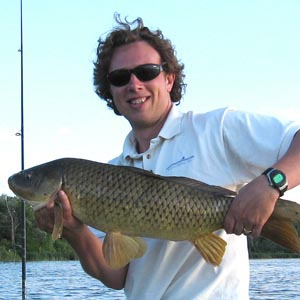Black Sea Bass Change Sex for Survival
Rutgers study finds nearly a third of the bass population that spawn as females become males
Rutgers marine researchers and New Jersey fishermen are piecing together the details of the strange, gender-bending sex lives of black sea bass – a study that could improve understanding of the bass population and help the beleaguered recreational fishing industry.
Scientists have long known black sea bass are “protogynous hermaphrodites,” a species in which fish that begin life as females can switch gender to male. But the details of how and why that happens are not completely understood.
Now, there’s thinking the change is triggered when the number of males in a local population declines. Not enough guys? Some black sea bass ladies make the switch.
“It sounds crazy, right? But from an evolutionary perspective, it’s a perfect way to keep balance in a population,” said Olaf Jensen, an assistant professor with Rutgers’ Department of Marine and Coastal Science leading the project. “If it’s operating out in nature, maybe we don’t have to worry so much about fishing pressure removing the big males and skewing the sex ratio.”
This self-propelling sex change could help biologists and government fisheries managers to better assess the overall black sea bass stock, calculations that up to now have been forcing season closures and lost money for the shore’s party and charter boat fleet. Ignoring the influence of sex changes on population dynamics could lead to mistakes in estimating the stock size and how fishing seasons and catch limits should be set.

The idea for the project started in 2010, when Jensen was talking to Eleanor Bochenek, director of the Fisheries Cooperative Center at Rutgers Haskin Shellfish Research Laboratory, who works with fishermen and other people who make a living on the water.
“We were talking about the challenges the industry was facing. In 2010 the fishing regulations for summer flounder were getting really tight, so black sea bass became even more important to the party boat fleet,” Jensen said.
“They’ve got the recreational season whittled down to very little,” said Adam Nowalsky, captain of the Karen Ann II, a 35-foot charter fishing vessel based in Atlantic City, who helped catch and tag fish for the study.
Those restrictions were a factor in last winter’s sale of the Doris Mae IV by the Eble family of Barnegat Light, ending their 70-year party boat business. Renowned black sea bass captains, Ron and Charlies Eble, lost their valuable late-season offshore fishery.
“That’s why we sold the boat. We couldn’t fish, we couldn’t make a living,” said Cindy Eble, Ron’s wife.
At the same time, fisheries biologists and government managers responsible for keeping fish populations healthy had to admit they really did not know what was going on with black sea bass.. The fish had become one of the “data-poor species” that the National Marine Fisheries Service has been trying to figure out.
“One thing that hasn’t been accounted for is how they change sex,” Jensen said. “Through the research we found about 30 percent of the population spawn first as males. Then after the summer spawning season, some female bass become male.”
Apparently the peak time for the shift is October, after the fishing season subsides, Jensen said. Anglers prefer big male bass – the so-called humpbacks with thick bodies and meaty fillets – and other research suggests higher rates of sex change could be a reaction to the changes fishing forces on the population.
Volunteer fishermen and a small group of charter fishing captains made the project work. By catching, tagging and releasing fish alive, they helped the researchers see differences between male and female bass in feeding, aggressive behavior and swimming ranges.
“We took them to places where we thought the bass would be … where sea bass fishing has been very good,” Nowalsky said. Other experienced charter skippers and a commercial trap fisherman helped out too.
Jensen, Rutgers graduate student, Mikaela Provost, and their crew of volunteers fished, tagged and spread the word among New Jersey’s fishing community. There were 31 trips and 85 anglers volunteered, helping to tag near 1,500 fish. Jensen waited anxiously for the results.
One out of every three tagged fish got caught again and reported – a good return rate for a tagging study, most likely because black sea bass tend to stick close to their home habitat and New Jersey anglers fish the artificial reef sites often, Jensen said.
Understanding what triggers sex change could prove valuable for the aquaculture industry. With their high market value, black sea bass are a candidate for fish farming. David Berlinsky, a zoologist at the University of New Hampshire, has been studying factors involved in the bass gender shift and collaborated with the Rutgers group by analyzing tissue samples from the New Jersey fish for signs of sex change.
One trigger might be purely social: Female bass segregated in their own tanks at the New Hampshire project, but could see male bass in a neighboring tank, made the change when they saw fewer males, Jensen said.
“This research represented an important first step toward properly accounting for the complex life history of black sea bass in the species’ assessment and management,” Jensen’s team wrote in a summary paper.
Nowalsky, the charter captain who worked with Jensen, believes the study shows that fishing does not put so much pressure on the black sea bass population as has been suggested by some assessments.
Media contact: Ken Branson, kbranson@ucm.rutgers.edu; 848-932-0580; cell 908-797-2590